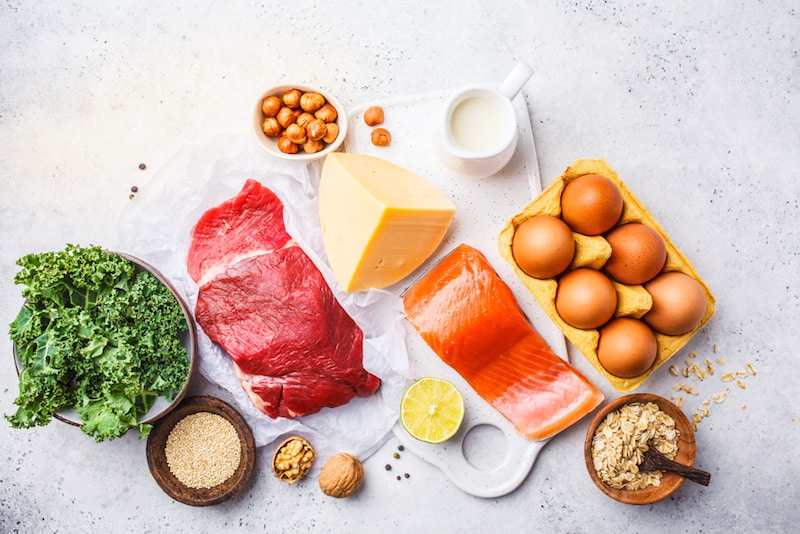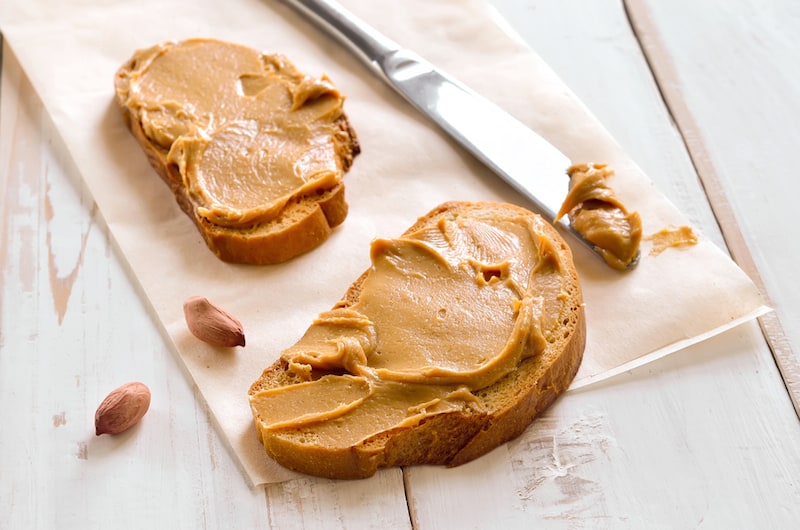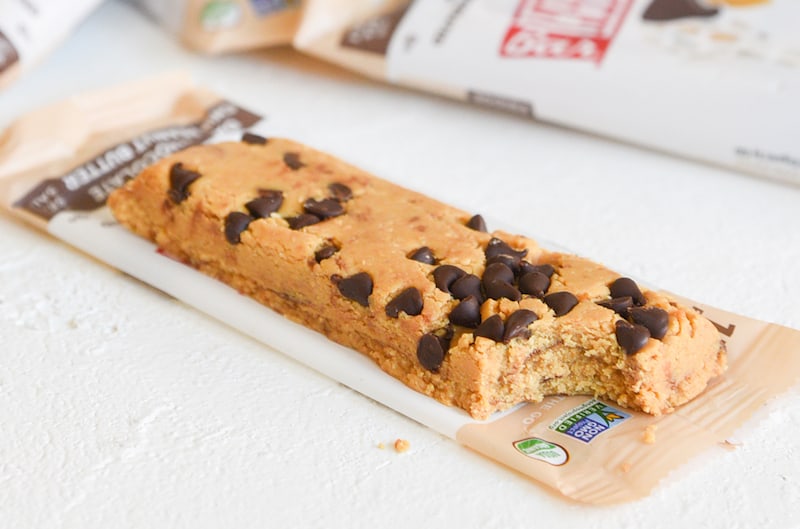Protein: we’re all crazy about it. The fact of the matter is, if you’re a health-conscious person who cares about eating clean and healthy, then protein is likely something that you give a lot of attention. Though we live in a world with a new diet or meal plan hitting the scene almost every week (eat this, not that! Carbs are the enemy—no wait, they’re great! Fat is bad, no wait, it’s fine!) protein, particularly protein bars, never seems to go out of style.
Protein Bars: Our Easy & Favorite Way To Eat Protein
You don’t have to chat with a nutritionist or diet expert—just ask the average person off the street and they’ll likely bring up protein when asked about healthy eating. Almost anyone will tell you that without a doubt, eating lots of protein is key for a healthy diet. A fan favorite way to get protein is in the form of a protein bar—convenient, portable, and delicious. But have you ever stopped and asked yourself just how much protein you actually should be eating in the ideal bar? Is more always more? Is there a golden amount? Does it depend on if you’re trying to lose weight, gain muscle, or just maintain a healthy body and stay satisfied while well-fed?
Let’s dig in. But first, why the big hype over protein in the first place, and just what does it even do for us?
What Is Protein Really Good For?
There’s a good reason we’re all so pumped about protein. At the end of the day, protein is absolutely a must for overall health and a nutrient that our body truly rely on.
You’ve probably heard the key “macronutrients,” and protein is just that. One of the three basic group of nutrients our bodies need for fuel and growth—along with carbs and fats—protein is an essential food group and has certainly earned its rightful place on our tables.
In the most basic sense, protein is a complex molecule, one that acts as a literal building block for our entire bodies. Hair, skin, nails, muscle, bone…what do they all have in common? None of them could exist, quite literally, without protein.
To break it down even further, protein molecules are built from amino acids. These chemical compounds can all be classified as either essential or non-essential—the essential ones (there are nine), are called this because we can’t create them organically in our bodies, meaning we rely on food to get them.
You’ve likely heard the advice that we should focus on eating the complete proteins, which just refers to those that contain both essential and non-essential amino acids. While there’s some merit to that notion, the most important thing is that you’re consuming quality protein from clean, wholesome sources. Not all proteins are created equal, so making sure you consume these “clean” source that our bodies can fully utilize, such as nuts, superfoods, and legumes is more important than whether you’re eating complete proteins with every meal.

Protein As Energy
For one, it delivers crucial stores of energy and strength to our bodies, keeping us full, energized throughout our day, and able to function at 100%. Along with the other two key macronutrients, carbs and fat, protein is a must to include in your meals, and is especially good at keeping satiation levels up throughout the day. This means fewer munchies and binging urges, since we’re getting quality nutrition that will keep us naturally fueled up, energized, and ready to tackle our days.
Protein and Your Fitness Goals
Ask any bodybuilder or gym rat: nowhere does protein get as much as hype as in the world of fitness.
Though no one’s disputes that protein is needed as a part of any healthy diet—whether you’re an Olympic athlete or a yogi, or your main form of exercise is chasing around your kiddos, it’s true that protein is especially important and may be needed in larger quantities if you’re an athlete looking to bulk up or transform your physique.
When we put our bodies through a rigorous workout such as a weight lifting session or spin class, our muscles undergo stress, which actually creates tons of micro-tears and rips in the muscle tissue itself. If you’ve ever felt sore the day after a workout, you’re literally feeling the tears that occurred to your muscle fiber. As soon as we leave the gym or spin class, our muscles begin the process of rebuilding, and that’s where protein comes into play.
Without enough protein in your bar or snack, the body doesn’t have what it needs to rebuild. You can think of working out but falling to eat balanced meals, ones including protein, as the equivalent of trying to run a car on an empty tank of gas.
Not only does protein play a vital role in rebuilding and repairing muscle and our overall ability to recover from our workouts each day, but protein consumption is also your BFF if weight or fat loss is your goal. Since protein keeps us energized and feeling full longer, eating enough helps us to stay satisfied, AKA better able to pass up those break room cookies or pizza we don’t really need.
Ok, So How Much Protein Is Enough?
As we’ve seen, protein undeniably plays a key role in all our health and vitality. Unsurprisingly, an entire industry has sprung up to cater to this need and make sure we’re getting enough of it, especially with the on-the-go lifestyles that leave many of us eating our food from Tupperware and in the car (more on why bars can be the perfect solution, further on).
Though we all know we should be eating it, if you ask ten people how much protein is ideal, you’ll likely get ten different answers. In other words, you’re not to blame if you’ve found yourself a little fuzzy on the question: how much protein is enough?
That’s probably because there’s no one-size-fits-all answer to that question, since protein needs differ based on age, gender, weight, and activity level. A male bodybuilder trying to put on mass and muscle growth is going to need more protein than a toddler or a child, just like a breastfeeding woman will need more than an average young man.
High-protein diets like paleo and keto make it seem like protein is the end-all-be-all to great health, but in general, we don’t need as much as you probably think. Most health organizations recommend a (very attainable) daily amount of around .08 grams per kilogram of bodyweight, or .36 grams per pound. For those of you who don’t love crunching numbers, that roughly breaks down to around a modest 46 grams for the average healthy female, or just slightly more for men (https://www.webmd.com/food-recipes/protein).
One thing to understand about this recommended daily amount (RDA), is that this number tells us the minimum we need to get to be healthy—though it actually accounts for a little more than what most of us need, just to be safe. Meaning, if we achieve the RDA, most of us are getting slightly more than we need—so you can rest assured your body is truly getting plenty, and there’s no need to go crazy on protein past the RDA range.
With this modest goal in mind, let’s talk about one of the most convenient and easily ways to achieve a large portion of it daily—with everyone’s favorite on-the-go snack, the good old protein bar, and how to chose one that’s right for your goals.
Why A Protein Bar Makes Sense
So, you’re a busy person, but still prioritize your health and nutrition. First off, give yourself a pat on the back! Secondly, you have some options. If chosen wisely, a protein bar from the store can absolutely be a wise dietary choice and a great daily snack or post or pre-workout treat. There are just a few things to keep in mind when choosing your bar.
Before we go into the good, the bad, and the things to avoid, let’s look at why a bar makes sense.
First off, convenience. Who isn’t busy these days? Though in an ideal world we’d love to be whipping up all our meals in our kitchens and never having to rush out the door, the reality is that we bet a good few of your meals each week or even day are eaten out of Tupperware, on the go, or from your car. That’s why a bar makes a lot of sense, especially if your schedule is crammed.
Another great bar “pro” is their combined nutrients and macros. A healthy bar is one with an ideal combo of healthy carbs, fats, and proteins, in one conveniently wrapped-up package. Eating this ideal combo delivers plenty of nutrients and energy to get you through your midmorning meeting, after-school pickup, or post-workout errands run. Unlike something that may be too low in calories or protein to hold you over, such as an apple or carrot and hummus, a protein bar should actually keep you satisfied for at least a couple hours, meaning if your schedule is hectic and you find yourself running around and not wanting to go hungry, it’s the ideal choice.
How much protein should your ideal bar contain?
Here’s where things get a little interesting.
Most of us would probably assume that more is more, but this isn’t the case with protein bars, or protein in general.
While the general consensus in the world of fitness and bodybuilders and even regular Jane health-conscious people is to guzzle down protein in whatever way we can get it, if that’s your approach, you may be doing more harm than good, (or at least spinning your wheels.) As discussed, the RDA is already accounting for a little extra protein than most of us probably need—you can think of those extra grams as a cushion, just to make sure you’re good. So, if you’re trying to eat more than the RDA, whether that’s in the form of way-oversized chicken breasts for dinner or protein bars with 40 + grams of protein, you’re going way overboard.
In terms of protein content, bars available at stores can vary widely—some contain less than 10 grams (many candy bars inadvertently contain more than this, though also far more calories, sugar, and fat), while those on the higher end clock in around 40 grams. For a typical healthy woman who only needs around 45 grams of protein in an entire day, a bar that contains even 5-10 grams makes a great snack. Presumably, you’ll be eating several other meals and snacks throughout the day, which will easily provide the rest of the protein you need.
And if you make sure your diet includes a well-rounded selection of whole foods you’re likely meeting the RDA for protein without even realizing it.
Whole foods to add to your diet:
- Produce
- Whole grains
- Healthy fats
- Leafy green veggies
- Legumes
- Tofu
- Fortified plant milks
- Lean meat
- Faux meat (like Beyond Meat)
For those trying to bulk up, put on weight or muscle, or smash some serious goals in the gym, the research points to the ideal number as somewhere around 20-30 grams of protein in a bar, if you’re using that as your post-workout snack. Interesting to note, many bodybuilders have the assumption that if they can pack in 50 grams of protein after a workout, their muscles would repair better—since protein is so essential for the repairing and growth of muscles after a strenuous workout.
However, dispelling the “more is more” notion, a study compared the results of those who consumed around 90 grams of protein post workout, and found they saw no difference in results (in terms of muscle repair and growth) than those who only ate 30 grams. The same study found that the ideal range of protein to consume post workout would be around 30 grams—that amount provided ideal muscle benefits, while eating more didn’t improve the benefits at all.
Other researchers have tested this “how much protein can the body absorb” idea and also found that around 30 grams of protein will go straight to aiding muscle repair and growth. They found that eating this amount in one sitting, or up to this amount, does have measurable benefits. However, if you were to get much more than this, the protein could wind up stored as extra fat.
Bottom Line On Protein Bars?
Protein is essential, a healthy, balanced diet is key to achieving the RDA, and clean, healthy bars are the perfect convenient snack to ensure this. Make sure the bar you’re choosing is totally clean, packed with wholesome and real ingredients—nothing whipped up in a lab–and fits your protein needs.
Want to add clean, whole food protein into your diet? Perfect Bar fits that bill – try our whole food protein bars today.
Shop Perfect Bar
Sources:
https://www.mindbodygreen.com/0-12047/14-great-sources-of-clean-protein.html
https://www.healthline.com/nutrition/how-much-protein-per-day
https://www.webmd.com/food-recipes/protein
https://www.verywellfit.com/what-are-the-benefits-of-eating-protein-bars-2507020
https://www.quickanddirtytips.com/health-fitness/healthy-eating/know-your-nutrients/how-much-protein-can-the-body-absorb
https://www.eatright.org/fitness/sports-and-performance/fueling-your-workout/protein-and-the-athlete
Want more health hacks and wellness insights? We got you covered. You'll also receive a code for 15% off your first order!





This post is really helpful, it contains lots of information. Thank you so much for gathering this amount of info, it helps a lot. 🙂
Hi Henry – Of course! Thanks for giving it a read.
Good article . The way how you explain this strategies. Is very professional.
Hi Linda – Thanks for the great feedback! We’re glad that you enjoyed this one.
Great info now I know how much protein to take in daily